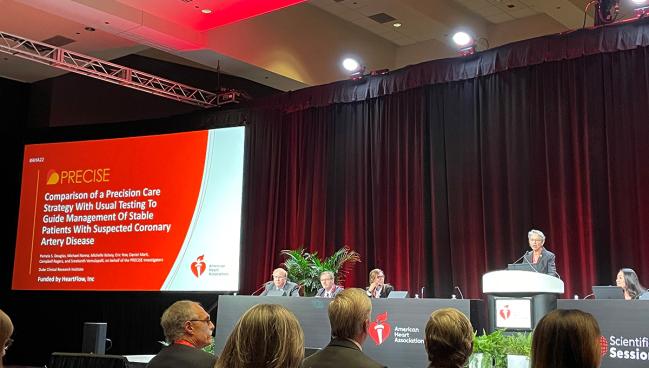PRECISE CT-Based Strategy Allows Clinicians to ‘Do Less’ for Stable Chest Pain
The pathway, based on the PROMISE Minimal Risk Score, resulted in a 71% lower risk of hard clinical events at 1 year.

CHICAGO, IL—(UPDATED) In patients with suspected CAD who present with stable chest pain, use of Precision, a CT-based strategy derived from the PROMISE trial, as compared with usual care produces about a 70% reduction in the composite clinical endpoint of death, nonfatal MI, and catheterization without obstructive CAD at 1 year, data from the PRECISE trial show.
Moreover, the Precision group underwent less testing and fewer cardiac catheterizations overall.
While the latest American College of Cardiology and American Heart Association (ACC/AHA) chest pain guidelines support a wide variety of modalities for triaging stable chest pain, Pamela Douglas, MD (Duke Clinical Research Institute, Durham, NC), who presented the PRECISE findings here today at the 2022 AHA Scientific Sessions, told TCTMD she hopes these results will merit an update.
“No one ever knows with guidelines, but this is the first time that we have randomized trial evidence supporting CT with selective FFR-CT, as it's been observational until this point,” she said. “This is the first ever time in this space that we have done a prospective validation of a risk score to do less. . . . I hope that this will be noticed by the guideline writers and be class 1, level of evidence A in support of the care pathway that we tested in PRECISE.”
In agreement, Martin Leon, MD (NewYork-Presbyterian/Columbia University Irving Medical Center, New York, NY), during a press conference said: “Even as an interventionalist, I support doing less. So, the idea of being able to defer catheterization and have quality invasive procedures based on good science and informed decisions makes sense.” In addition, the Precision pathway studied here “allows you to do more,” he continued, “and by more, I mean the intensity of the pharmacologic management of these patients is exaggerated. It may be that that benefit is as important as the reduction in resources required to make an accurate diagnosis.”
Commenting on the findings for TCTMD, B. Hadley Wilson, MD (Sanger Heart & Vascular Institute, Atrium Health, Charlotte, NC), vice president of the American College of Cardiology, said he “would not be surprised” if these results end up changing the guidelines, but added that having follow-up through 3-5 years “would be even better.”
Ron Blankstein, MD (Brigham and Women's Hospital, Boston, MA), who served on the writing committee for the 2021 ACC/AHA chest pain guidelines, said in the session’s discussion, “This is not only a trial that supports the guideline, but it will very much inform future guidelines.”
Yet, he acknowledged that 1 year is too short to show any changes in death or MI, “especially in lower risk patients.” The follow-up period would have to be “substantially longer” to show a benefit in that regard, according to Blankstein.
PRECISE Results
For the study, Douglas and colleagues randomized 2,103 patients (mean age 58 years; 50% women) with suspected CAD and stable chest pain to either the Precision strategy or usual care. For the Precision strategy, testing was assigned by the PROMISE Minimal Risk Score with low-risk patients receiving deferred testing and elevated-risk patients received coronary CT angiography (CCTA) with or without measurement of CT-derived fractional flow reserve. Usual testing consisted of functional testing or direct catheterization regardless of risk.
Patients were enrolled between December 2018 and May 2021 at 65 sites in North America and Europe. All subsequent care and testing decisions were made by on-site clinicians, and guideline recommended medical therapy was recommended for all.
In the Precision arm, 48% and 31% of the 1,057 patients, respectively, received CCTA and CCTA plus FFR-CT. A wider variety of testing strategies were used in the usual-care group (n = 1,046) including SPECT/PET (32%), stress echo (30%), treadmill ECG (11%), stress CMR (10%), and direct referral to invasive coronary angiography (10%).
After a median follow-up of 11.8 months, the Precision strategy resulted in a significantly lower MACE rate (composite of all-cause death, nonfatal MI, and catheterization without obstructive CAD) compared with usual testing (4.2% vs 11.3%; adjusted HR 0.29; 95% CI 0.20-0.41). This was driven by a lower rate of catheterization (2.6% vs 10.2%; adjusted HR 0.18; 95% CI 0.12-0.30). There were no significant differences in all-cause death or nonfatal MI alone between the study arms.
Our conclusion is that the Precision strategy is a preferred approach in evaluating patients with stable symptoms and suspected coronary artery disease. Pamela Douglas
“We accomplished the goal of performing less testing and having a higher testing yield,” Douglas said during her presentation, noting 18.3% versus 13.3% positive test rates for the Precision strategy and usual care, respectively (P < 0.01). Patients in the study arm also underwent approximately 50 fewer diagnostic catheterizations than those receiving usual testing, but about 45 more revascularizations.
The Precision pathway also improved the rate of lipid-lowering and antiplatelet use for patients, and there was a “similar and substantial reduction in angina” observed in both arms, according to Douglas.
“PRECISE addressed critical knowledge gaps in the evaluation of symptomatic low-to-intermediate risk patients with suspected CAD by defining and then testing a specific care pathway that is concordant with guideline recommendations,” Douglas concluded. “Our conclusion is that the Precision strategy is a preferred approach in evaluating patients with stable symptoms and suspected coronary artery disease.”
Reimbursement and Cost-effectiveness
“We are seeing a continuing evolution of improvement of coronary CTA, and this is as an interventional cardiologist speaking,” Wilson said. This study “further solidifies the findings of PROMISE, and now is going beyond that in a positive way to really bring home that this is potentially the way of assessing all patients in the future with suspected coronary disease and doing it safely,” he continued.
With reimbursement widely acknowledged as one of the main limitations for the expansion of CCTA in practice, Wilson said these findings should be enough to encourage a rethink from payers like the US Centers for Medicare & Medicaid Services (CMS). “That kind of evaluation is already going on currently with CMS, and particularly with the addition of coronary FFR with CTA,” he said. “So if this continues to be shown to be a superior and safer way and more efficient way to treat patients, I think that the reimbursement, particularly for the FFR portion of this, should be in line for that.”
Douglas said her team is in the process of conducting a cost-effective analysis of the two approaches. “Certainly [with] less testing, less catheterization, we would assume less costs,” she noted. “But there was, as you saw, a slightly higher rate of revascularization, which has to factor into that as well. We don’t have an answer to that yet.”
Going forward, Wilson would like to see more research perhaps comparing FFR-CT with angiographic FFR “sort of like a FAME CCTA FFR comparison trial.”
Yael L. Maxwell is Senior Medical Journalist for TCTMD and Section Editor of TCTMD's Fellows Forum. She served as the inaugural…
Read Full BioSources
Douglas PS. Comparison of a precision care strategy with usual testing to guide management of stable patients with suspected coronary artery disease. Presented at: AHA 2022. November 6, 2022. Chicago, IL.
Disclosures
- PRECISE was funded by HeartFlow.
- Douglas reports receiving research support from Caption Health and Kowa Pharmaceuticals and honoraria from UpToDate/Kluwer.
- Wilson reports no relevant conflicts of interest.



Comments